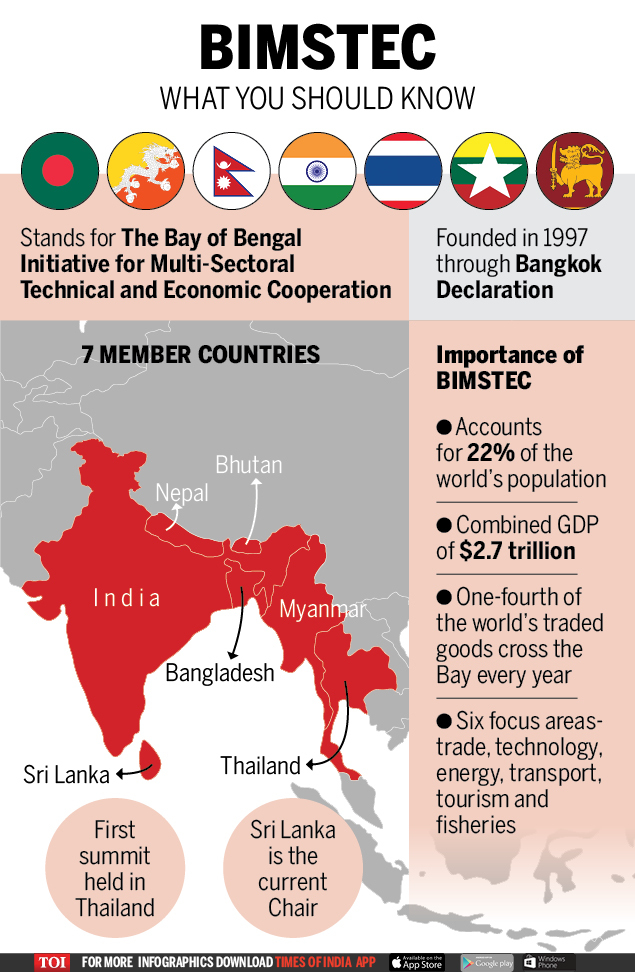
In News
Recently, the External Affairs Minister of India participated in the 17th BIMSTEC Ministerial Meeting.
- The meeting is chaired by Sri Lanka, and was held in a virtual mode with the participation of all BIMSTEC Member States.
Major Highlights of the meet
- India is committed to building the momentum of regional cooperation under the BIMSTEC framework and make the organization stronger, vibrant, more effective and result-oriented.
- It was highlighted that India achieved progress as a Lead Country in Counter-Terrorism & Trans-national Crime, Transport & Communication, Tourism, and Environmental & Disaster management and other activities undertaken by India to deepen BIMSTEC cooperation.
- The meeting endorsed the BIMSTEC Master Plan for Transport Connectivity for adoption at the next BIMSTEC Summit and three MoUs / Agreements for signing at the next BIMSTEC Summit, namely
- The BIMSTEC Convention on Mutual Legal Assistance in Criminal Matters.
- MoU on Mutual Cooperation between Diplomatic Academies/Training Institutions of the BIMSTEC Member States.
- Memorandum of Association on the Establishment of BIMSTEC Technology Transfer Facility (TTF) in Colombo, Sri Lanka.
- The meeting took note that the BIMSTEC Centre for Weather and Climate, being hosted in India, is fully functional with the state of the art facilities to provide Disaster Early Warnings.
About BIMSTEC
- It is a regional organization comprising seven member states lying in the littoral and adjacent areas of the Bay of Bengal constituting a contiguous regional unity.
- Members: India, Thailand, Myanmar, Nepal, Bangladesh, Sri Lanka and Bhutan.
- The grouping holds annual meetings hosted by member states based on alphabetical rotation. Sri Lanka is the host nation this time.
- It was established through the Bangkok Declaration in 1997.
- It will focus on enhancing multilateral cooperation and engagement with countries from around the globe to collectively develop and strengthen the startup ecosystems.
- Aims: To develop technological and economic cooperation in the Southeast Asian countries along the coast of the Bay of Bengal. It also establishes the relationship between SAARC and SEAN members.
- It aims to accelerate economic growth and social progress among members across multiple sectors — trade, technology, energy, transport, tourism and fisheries, agriculture, public health, poverty alleviation, counter-terrorism, environment, culture, people to people contact and climate change.

Image Courtesy: TOI
Importance of BIMSTEC for India
- The region is home to roughly 22 percent of the global population with a combined GDP of over $2.7 trillion.
- It also has vast untapped natural resources.
- BIMSTEC connects South and Southeast Asia and also the ecologies of the Great Himalayas and the Bay of Bengal.
- It is a natural platform to fulfil our key foreign policy priorities of ‘Neighborhood First’ and ‘Act East,”.
- Roughly one-quarter of India’s population, live in the four coastal states adjacent to the Bay of Bengal (Andhra Pradesh, Orissa, Tamil Nadu, and West Bengal).
- About 45 million people, who live in landlocked Northeastern states, will have the opportunity to connect via the Bay of Bengal to Bangladesh, Myanmar and Thailand, opening up possibilities in terms of development.
- (Projects taken: India-Myanmar Kaladan Multimodal Transit Transport Project, India-Myanmar-Thailand Trilateral Highway, Bangladesh, Bhutan, India and Nepal (BBIN) Project.)
Challenges
- Persisting organisational weaknesses: Inconsistent levels of commitment and a general ambiguity regarding how to engage with other institutional actors have been the key reasons hampering the functioning of the organisation.
- Poor connectivity: It is troubled by poor road and rail connectivity, insufficient last-mile links and cumbersome customs and clearance procedures which hamper trade.
- Lack of Cohesion & coordination: Cohesion among the members has been difficult to achieve mainly because of the Rohingya refugee crisis which created bitterness between Myanmar and Bangladesh.
- This affected the working of the organisation to some extent as it could not develop a common charter.
- China’s financial hegemony: As China has undertaken a massive drive to finance and build infrastructure in South and Southeast Asia through the Belt and Road Initiative in almost all BIMSTEC countries, except Bhutan and India, BIMSTEC is a new battleground in the India-China battle for dominance.
Way Forward
- BIMSTEC might be a viable option for India to maintain its foreign policy discourse. However, India will have to take into account the fact that in Asia, economics and politics have historically been deeply integrated, and not fall into the trap.
- It was announced that the organisation will soon have a common set of rules and goals and the text of the BIMSTEC Charter has been finalised.
- We hope that all member states will timely complete their internal procedures for its adoption at the fifth BIMSTEC summit
- BIMSTEC could develop codes of conduct that preserve freedom of navigation and apply existing law of the seas regionally.
- In addition, BIMSTEC could stem the region’s creeping militarisation by instituting, for instance, a Bay of Bengal Zone of Peace that seeks to limit any bellicose behaviour of extra-regional power.
Previous article
Suez Canal Crisis
Next article
Harmonized System of Nomenclature Code